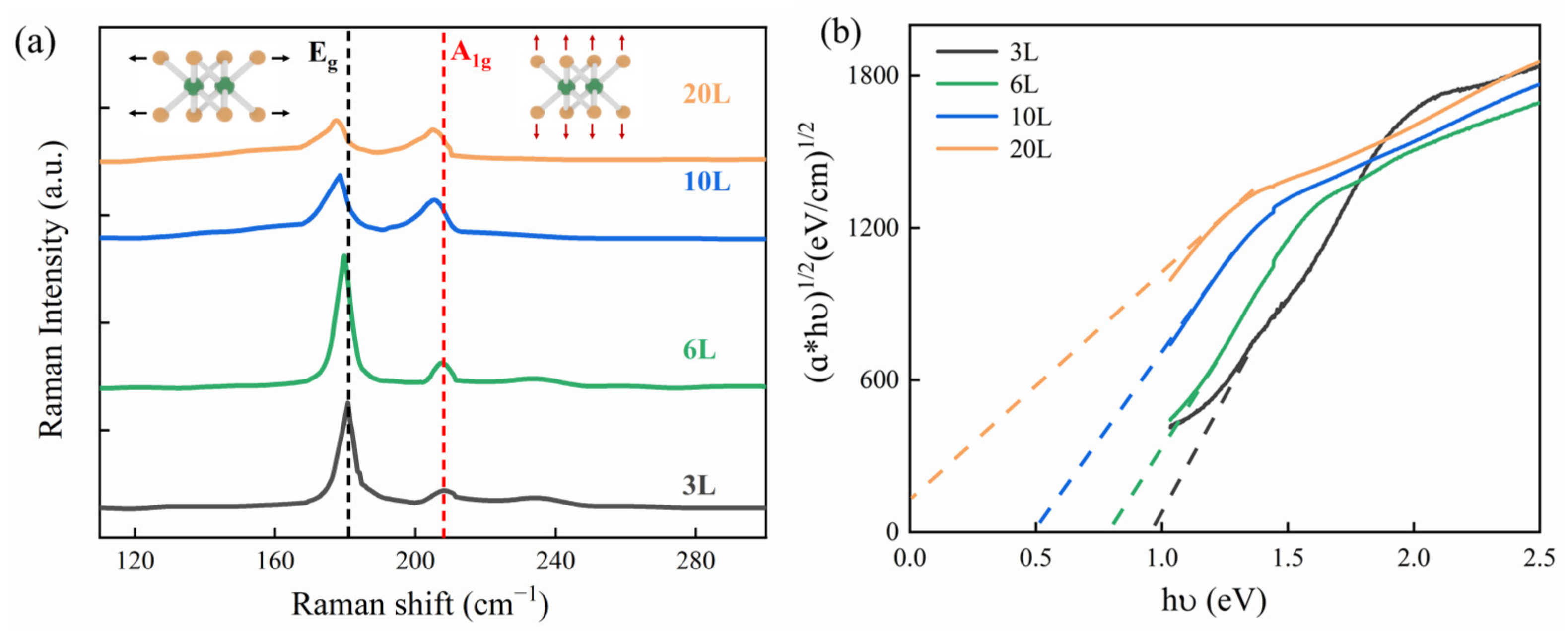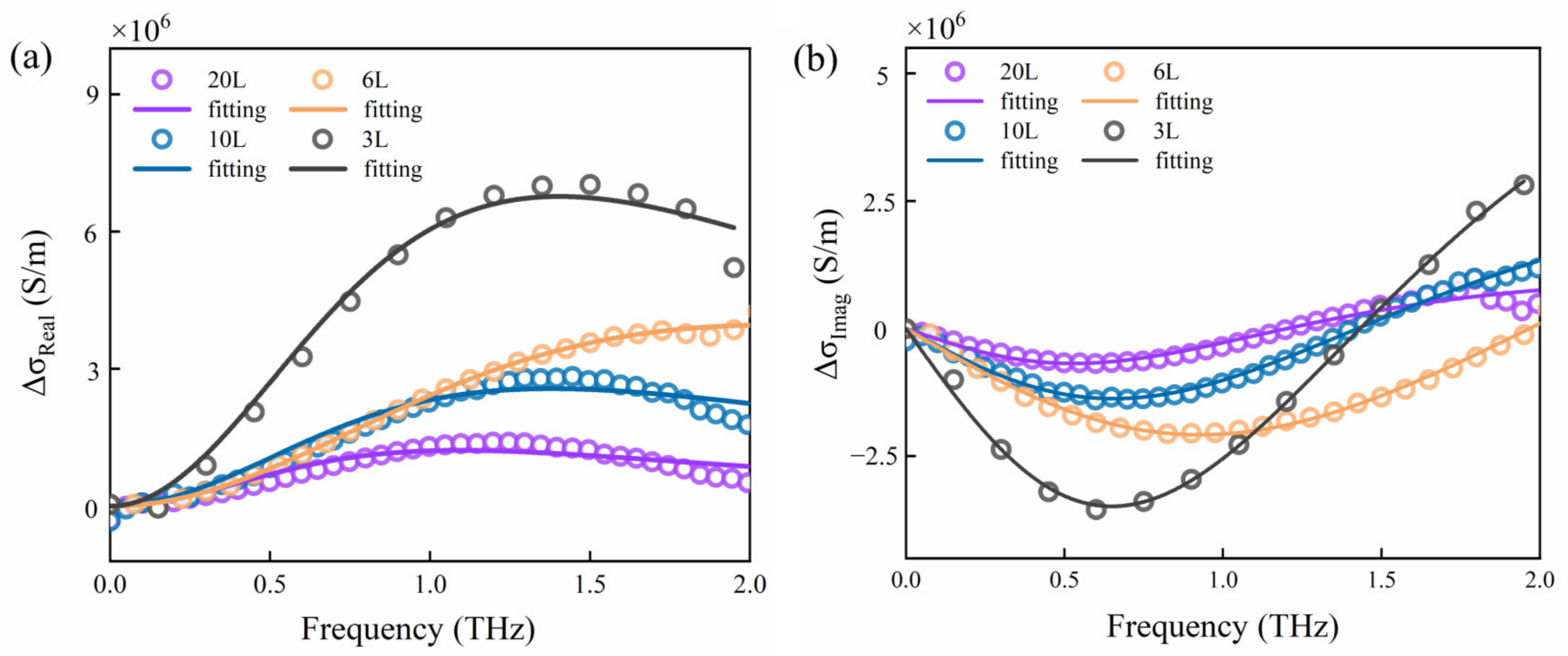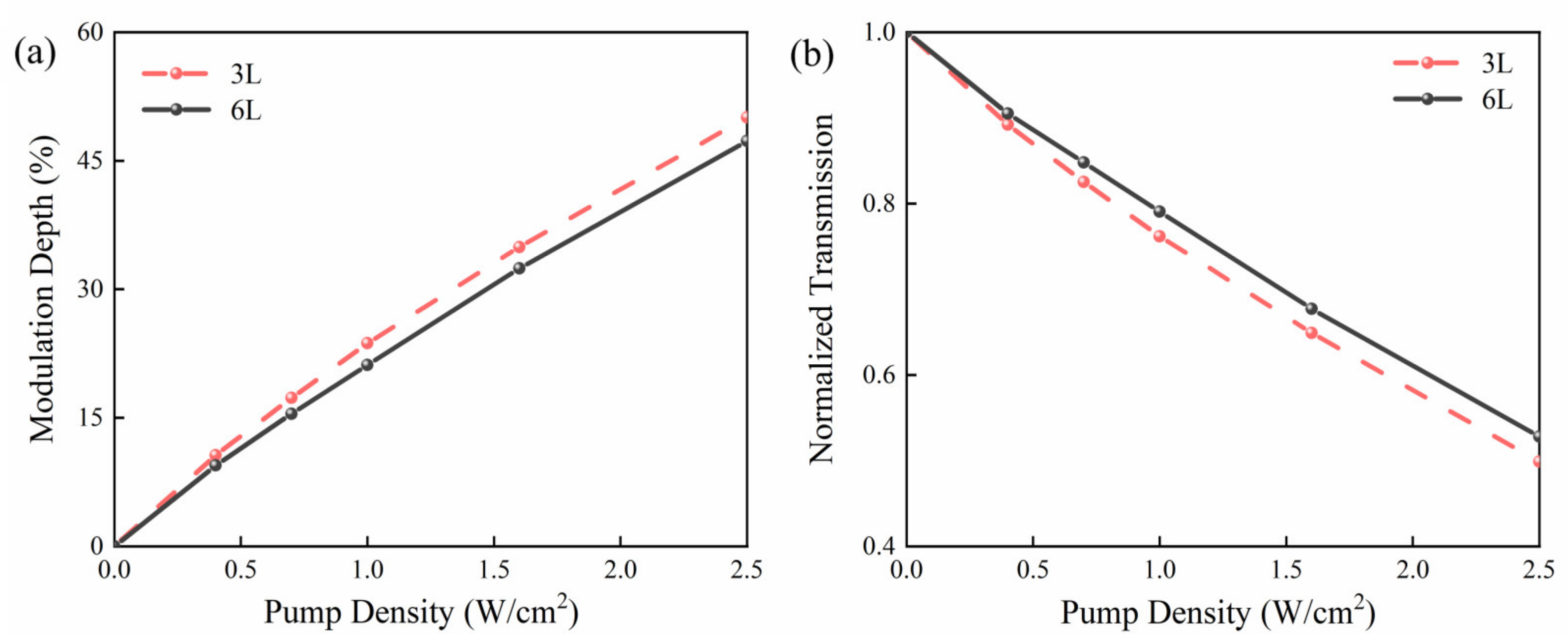Optically Controlling Broadband Terahertz Modulator Based on Layer-Dependent PtSe2 Nanofilms
Abstract
1. Introduction
2. Sample Characterization
3. Results and Discussion
4. Conclusions
Author Contributions
Funding
Institutional Review Board Statement
Informed Consent Statement
Data Availability Statement
Conflicts of Interest
References
- Cai, X.; Sushkov, A.; Suess, R.; Jadidi, M.; Jenkins, G.; Nyakiti, L.; Myers-Ward, R.; Wheeler, V.; Eddy, C.; Yan, J. Sensitive room-temperature terahertz detection via photothermoelectric effect in graphene. Am. Phys. Soc. Nat. Nanotechnol. 2014, 9, 814. [Google Scholar] [CrossRef] [PubMed]
- Wu, X.; Pan, X.; Quan, B.; Xu, X.; Gu, C.; Wang, L. Self-referenced sensing based on terahertz metamaterial for aqueous solutions. Appl. Phys. Lett. 2013, 102, 5. [Google Scholar] [CrossRef]
- Federici, J.; Moeller, L. Review of terahertz and subterahertz wireless communications. J. Appl. Phys. 2010, 107, 22. [Google Scholar] [CrossRef]
- Koenig, S.; Lopez-Diaz, D.; Antes, J.; Boes, F.; Henneberger, R.; Leuther, A.; Tessmann, A.; Schmogrow, R.; Hillerkuss, D.; Palmer, R.; et al. Wireless sub-THz communication system with high data rate. Nat. Photonics 2013, 7, 977. [Google Scholar] [CrossRef]
- Sensale-Rodriguez, B.; Yan, R.; Kelly, M.; Fang, T.; Tahy, K.; Hwang, W.; Jena, D.; Liu, L.; Xing, H. Broadband graphene terahertz modulators enabled by intraband transitions. Nat. Commun. 2012, 3, 7. [Google Scholar] [CrossRef]
- Sun, Z.; Martinez, A.; Wang, F. Optical modulators with 2D layered materials. Nat. Photonics 2016, 10, 227. [Google Scholar] [CrossRef]
- Zhao, X.; Wang, Y.; Schalch, J.; Duan, G.; Crernin, K.; Zhang, J.; Chen, C.; Averitt, R.; Zhang, X. Optically Modulated Ultra-Broadband All-Silicon Metamaterial Terahertz Absorbers. ACS Photonics 2019, 6, 830. [Google Scholar] [CrossRef]
- Zhang, Y.; Feng, Y.; Zhu, B.; Zhao, J.; Jiang, T. Graphene based tunable metamaterial absorber and polarization modulation in terahertz frequency. Opt. Express 2014, 22, 22743. [Google Scholar] [CrossRef]
- Cen, C.; Zhang, Y.; Chen, X.; Yang, H.; Yi, Z.; Yao, W.; Tang, Y.; Yi, Y.; Wang, J.; Wu, P. A dual-band metamaterial absorber for graphene surface plasmon resonance at terahertz frequency. Phys. E 2020, 117, 8. [Google Scholar] [CrossRef]
- You, X.; Wang, C.; Huang, J.; Gao, X.; Zhang, Z.; Wang, M.; Huang, Y.; Zhang, C.; Jiang, Y.; Wang, J.; et al. Towards 6G wireless communication networks: Vision, enabling technologies, and new paradigm shifts. Sci. China-Inf. Sci. 2021, 64, 74. [Google Scholar]
- Rahm, M.; Li, J.; Padilla, W. THz Wave Modulators: A Brief Review on Different Modulation Techniques. J. Infrared Millim. Terahertz Waves 2013, 34, 1. [Google Scholar] [CrossRef]
- Sounas, D.; Alu, A. Non-reciprocal photonics based on time modulation. Nat. Photonics 2017, 11, 774. [Google Scholar] [CrossRef]
- Xu, Y.; Song, Q.; Li, E.; Zhang, M.; Sun, Z.; Wang, T.; Liu, F.; Yan, P. Optically tunable split-ring resonators controlled lead sulfide quantum dots modulator for wide THz radiation. Nanophotonics 2022, 11, 1619. [Google Scholar] [CrossRef]
- Li, A.; Singh, S.; Sievenpiper, D. Metasurfaces and their applications. Nanophotonics 2018, 7, 989. [Google Scholar] [CrossRef]
- Sorger, V.; Lanzillotti-Kimura, N.; Ma, R.; Zhang, X. Ultra-compact silicon nanophotonic modulator with broadband response. Nanophotonics 2012, 1, 17. [Google Scholar] [CrossRef]
- Yao, H.; Ge, J.; Wang, C.; Wang, X.; Hu, W.; Zheng, Z.; Ni, Y.; Yu, S. A Flexible and Highly Pressure-Sensitive Graphene-Polyurethane Sponge Based on Fractured Microstructure Design. Adv. Mater. 2013, 25, 6692. [Google Scholar] [CrossRef]
- Qiang, R.; Du, Y.; Wang, Y.; Wang, N.; Tian, C.; Ma, J.; Xu, P.; Han, X. Rational design of yolk-shell C@C microspheres for the effective enhancement in microwave absorption. Carbon 2016, 98, 599. [Google Scholar] [CrossRef]
- Cai, G.; Jiang, H. A Modulator-Induced Defect-Formation Strategy to Hierarchically Porous Metal-Organic Frameworks with High Stability. Angew. Chem.-Int. Ed. 2017, 56, 563. [Google Scholar] [CrossRef]
- Shearer, G.; Chavan, S.; Bordiga, S.; Svelle, S.; Olsbye, U.; Lillerud, K. Defect Engineering: Tuning the Porosity and Composition of the Metal-Organic Framework UiO-66 via Modulated Synthesis. Chem. Mater. 2016, 28, 3749. [Google Scholar] [CrossRef]
- Liu, M.; Yin, X.; Ulin-Avila, E.; Geng, B.; Zentgraf, T.; Ju, L.; Wang, F.; Zhang, X. A graphene-based broadband optical modulator. Nature 2011, 474, 64. [Google Scholar] [CrossRef]
- Kim, K.; Choi, J.; Kim, T.; Cho, S.; Chung, H. A role for graphene in silicon-based semiconductor devices. Nature 2011, 479, 338. [Google Scholar] [CrossRef] [PubMed]
- Umemura, A.; Diring, S.; Furukawa, S.; Uehara, H.; Tsuruoka, T.; Kitagawa, S. Morphology Design of Porous Coordination Polymer Crystals by Coordination Modulation. J. Am. Chem. Soc. 2011, 133, 15506. [Google Scholar] [CrossRef] [PubMed]
- Cao, Y.; Gan, S.; Geng, Z.; Liu, J.; Yang, Y.; Bao, Q.; Chen, H. Optically tuned terahertz modulator based on annealed multilayer MoS2. Sci. Rep. 2016, 6, 9. [Google Scholar] [CrossRef]
- Chen, S.; Fan, F.; Miao, Y.; He, X.; Zhang, K.; Chang, S. Ultrasensitive terahertz modulation by silicon-grown MoS2 nanosheets. Nanoscale 2016, 8, 4713. [Google Scholar] [CrossRef]
- Ostrovsky, A.; Rickenstorff-Parrao, C.; Arrizon, V. Generation of the “perfect” optical vortex using a liquid-crystal spatial light modulator. Opt. Lett. 2013, 38, 534. [Google Scholar] [CrossRef] [PubMed]
- Degl’Innocenti, R.; Lin, H.; Navarro-Cia, M. Recent progress in terahertz metamaterial modulators. Nanophotonics 2022, 11, 1485. [Google Scholar] [CrossRef]
- Shen, S.; Liu, X.; Shen, Y.; Qu, J.; Pickwell-MacPherson, E.; Wei, X.; Sun, Y. Recent Advances in the Development of Materials for Terahertz Metamaterial Sensing. Adv. Opt. Mater. 2022, 10, 2101008. [Google Scholar] [CrossRef]
- Suo, P.; Zhang, H.; Yan, S.; Zhang, W.; Fu, J.; Lin, X.; Hao, S.; Jin, Z.; Zhang, Y.; Zhang, C.; et al. Observation of negative terahertz photoconductivity in large area type-ii dirac semimetal PtTe2. Phys. Rev. Lett. 2021, 126, 22. [Google Scholar] [CrossRef]
- Guo, C.; Hu, Y.; Chen, G.; Wei, D.; Zhang, L.; Chen, Z.; Guo, W.; Xu, H.; Kuo, C.; Lue, C.; et al. Anisotropic ultrasensitive PdTe2-based phototransistor for room-temperature long-wavelength detection. Sci. Adv. 2020, 6, 36. [Google Scholar] [CrossRef]
- Zhang, H.; Li, H.; Wang, F.; Song, X.; Xu, Z.; Wei, D.; Dai, Z.; Ren, Y.; Ye, Y.; Ren, X.; et al. PtSe2 Field-Effect Phototransistor with Positive and Negative Photoconductivity. ACS Appl. Electron. Mater. 2022, 4, 11. [Google Scholar] [CrossRef]
- Shen, J.; Xing, H.; Wang, L.; Hu, Z.; Zhang, L.; Wang, X.; Chen, Z.; Yao, C.; Jiang, M.; Fei, F.; et al. A van der Waals heterostructure based on nickel telluride and graphene with spontaneous high-frequency photoresponse. Appl. Phys. Lett. 2022, 120, 6. [Google Scholar] [CrossRef]
- Zhao, Y.; Qiao, J.; Yu, Z.; Yu, P.; Xu, K.; Lau, S.; Zhou, W.; Liu, Z.; Wang, X.; Ji, W.; et al. High-Electron- Mobility and Air-Stable 2D Layered PtSe2 FETs. Adv. Mater. 2017, 29, 1604230. [Google Scholar] [CrossRef]
- Wang, Y.; Li, L.; Yao, W.; Song, S.; Sun, J.; Pan, J.; Ren, X.; Li, C.; Okunishi, E.; Wang, Y.; et al. Monolayer PtSe2, a New Semiconducting Transition-Metal-Dichalcogenide, Epitaxially Grown by Direct Selenization of Pt. Nano Lett. 2015, 15, 4013. [Google Scholar] [CrossRef]
- Ciarrocchi, A.; Avsar, A.; Ovchinnikov, D.; Kis, A. Thickness-modulated metal-to-semiconductor transformation in a transition metal dichalcogenide. Nat. Commun. 2018, 9, 919. [Google Scholar] [CrossRef] [PubMed]
- Jakhar, A.; Kumar, P.; Moudgil, A.; Dhyani, V.; Das, S. Optically pumped broadband terahertz modulator based on nanostructured PtSe2 thin films. Adv. Opt. Mater. 2020, 8, 1901714. [Google Scholar] [CrossRef]
- Gong, Y.; Lin, Z.; Chen, Y.; Khan, Q.; Wang, C.; Zhang, B.; Nie, G.; Xie, N.; Li, D. Two-Dimensional Platinum Diselenide: Synthesis, Emerging Applications, and Future Challenges. Nano-Micro Lett. 2020, 12, 34. [Google Scholar] [CrossRef]
- O’Brien, M.; McEvoy, N.; Motta, C.; Zheng, J.; Berner, N.; Kotakoski, J.; Elibol, K.; Pennycook, T.; Meyer, J.; Yim, C.; et al. Raman characterization of platinum diselenide thin films. 2D Mater. 2016, 3, 7. [Google Scholar] [CrossRef]
- Karmakar, A.; Karthick, K.; Kumaravel, S.; Sankar, S.; Kundu, S. Surface Decoration of DNA-Aided Amorphous Cobalt Hydroxide via Ag+ Ions as Binder-Free Electrodes toward Electrochemical Oxygen Evolution Reaction. Inorg. Chem. 2021, 60, 2680. [Google Scholar] [CrossRef]
- Zheng, Z.; Peng, Z.; Yu, Z.; Lan, H.; Wang, S.; Zhang, M.; Li, L.; Liang, H.; Su, H. Thickness-dependent optical response and ultrafast carrier dynamics of PtSe2 films. Results Phys. 2022, 42, 106012. [Google Scholar] [CrossRef]
- Xu, S.; Yang, J.; Jiang, H.; Su, F.; Zeng, Z. Transient photoconductivity and free carrier dynamics in a monolayer WS2 probed by time resolved Terahertz spectroscopy. Nanotechnology 2019, 30, 8. [Google Scholar] [CrossRef]
- Lloyd-Hughes, J.; Jeon, T. A Review of the Terahertz Conductivity of Bulk and Nano-Materials. J. Infrared Millim. Terahertz Waves 2012, 33, 871. [Google Scholar] [CrossRef]
- Cocker, T.; Baillie, D.; Buruma, M.; Titova, L.; Sydora, R.; Marsiglio, F.; Hegmann, F. Microscopic origin of the Drude-Smith model. Phys. Rev. B 2017, 96, 16. [Google Scholar] [CrossRef]





| Parameters | ωp (THz) | τs (ps) | c |
|---|---|---|---|
| Layers | |||
| 3 | 0.23 | 0.07 | −0.94 |
| 6 | 0.21 | 0.09 | −0.96 |
| 10 | 0.17 | 0.11 | −1 |
| 20 | 0.15 | 0.14 | −1 |
Disclaimer/Publisher’s Note: The statements, opinions and data contained in all publications are solely those of the individual author(s) and contributor(s) and not of MDPI and/or the editor(s). MDPI and/or the editor(s) disclaim responsibility for any injury to people or property resulting from any ideas, methods, instructions or products referred to in the content. |
© 2023 by the authors. Licensee MDPI, Basel, Switzerland. This article is an open access article distributed under the terms and conditions of the Creative Commons Attribution (CC BY) license (https://creativecommons.org/licenses/by/4.0/).
Share and Cite
Su, H.; Zheng, Z.; Yu, Z.; Feng, S.; Lan, H.; Wang, S.; Zhang, M.; Li, L.; Liang, H. Optically Controlling Broadband Terahertz Modulator Based on Layer-Dependent PtSe2 Nanofilms. Nanomaterials 2023, 13, 795. https://doi.org/10.3390/nano13050795
Su H, Zheng Z, Yu Z, Feng S, Lan H, Wang S, Zhang M, Li L, Liang H. Optically Controlling Broadband Terahertz Modulator Based on Layer-Dependent PtSe2 Nanofilms. Nanomaterials. 2023; 13(5):795. https://doi.org/10.3390/nano13050795
Chicago/Turabian StyleSu, Hong, Zesong Zheng, Zhisheng Yu, Shiping Feng, Huiting Lan, Shixing Wang, Min Zhang, Ling Li, and Huawei Liang. 2023. "Optically Controlling Broadband Terahertz Modulator Based on Layer-Dependent PtSe2 Nanofilms" Nanomaterials 13, no. 5: 795. https://doi.org/10.3390/nano13050795
APA StyleSu, H., Zheng, Z., Yu, Z., Feng, S., Lan, H., Wang, S., Zhang, M., Li, L., & Liang, H. (2023). Optically Controlling Broadband Terahertz Modulator Based on Layer-Dependent PtSe2 Nanofilms. Nanomaterials, 13(5), 795. https://doi.org/10.3390/nano13050795






